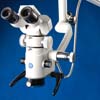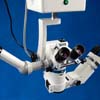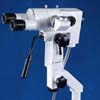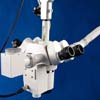ART.VIII.-Tumors of the Choroid
Almost all the tumors of this membrane are sarcomata, sometimes mixed with carcinomatous elements; exceptionally we meet also true carcinomata. These neoplasms almost always contain abundant pigment (melanotic). The ophtalmoscopic appearances vary, according as the tumor begins in the posterior part of the eye or near the ciliary body. In the latter case, we see brownish-colored prominences, which advance into the vitreous body behind the lens, or displace it and make their appearance at the periphery of the anterior chamber.When the tumor originates in the choroid, the serous effusion on its surface very soon produces separation of the retina. This separation masks the tumor; but, as the tumor grows, it reaches before long the separated membrane, and, if that has retained its transparency, we may distinguished behind it the smooth or nodulated tumor of the choroid, of a brownish or blackish color according to the amount of the pigmentation. When the sarcoma is poor in pigment, and the layer of fluid separating it from the separated retina very tin, we may, with an intense opthalmoscopic light, distinguish the vessel of the tumor (Becker).
In other cases, the retina becomes thickened, undergoes fatty degeneration, and then furnishes a yellowish reflection. But this reflection has not the opalesce of gliomatous tumor of the retina, nor does it show the rose-colored tint which gliomata do when highly vascular.
A very important symptoms in the diagnosis of choroidal tumors is the increase of intraocular pressure which accompanies their early stages, or at least the reaching of the separated retina by the neoplasm. We then observe all the symptom in the diagnosis of choroidal tumor is the increase of intraocular pressure which accompanies their early stages, or at least the reaching of separated retina by the neoplasm. We then observe all the symptoms of chronic glaucoma, viz, hardness of the ball, dilatation and immobility of the pupil, insensibility of the cornea, shallowness of the anterior chamber, dilatation of the subconjunctival veins, and, if it be still visible to the ophthalmoscope, escavation of the optic papilla and the formation of posterior sclerotic ectasia.
Simultaneously, the patients complain of sharp, shooting pains in the forehead and head on the same side as the disease eye, and these pains periodically undergo great exacerbations. Sometimes true acuteglaucoma supervenes. This has been several times observed after instillation af atropine. As a rule, the lens becomes opaque.
This condition may last till the tumor pierces the sclerotic. At other times a second focus is developed simultaneously in the fundus of the orbit, causing exophthalmos and a certain amount of immobility of the eye. Again, the disease may end in the ulceration and perforation of the cornea, either from the insensibility of that membrane, or from the excess of intraocular pressure.
The destruction of the cornea gives rise to a purulent panophthalmitis, and the eye atrophies as far s the presence of the tumor permits it. An eye thus atrophied is distinguished from an ordinary stump by the following particulars: it is the seat of spontaneous, violent and periodic pains, whilst it is the seat of spontaneous, violent and periodic pains, whilst it is almost insensible to palpation. Moreover, the stump is of a special form, flat from before backwards; it preserves its equatorial diameter, and thus shows in a characteristic way on its anterior surface the depression produced by the insertion of the four recti mascles.
Again, as the atrophied eye prevents the neoplasm fromm the growing forwards, it takes a retro-bulbar direction, pushing the eye in front of it so that the eye cannot shrink into the orbit as such eyes generally do.
These tumors spread to the parts beyond the eyeball; either by perforation of the sclerotic, generally anteriorly; or by the formation of neoplasms in the posterior portions of the periphery of the eyeball without perforation of the sclerotic, which remains intact; or the sarcomatous degeneration begins on the surface of the internal sheath of the optic nerve and in the neurilemma of the internal sheath of the optic nerve and in neurilemma of the secondary fibres.
All tumors of the choroid must be looked upon as malignant, likely to form secondary foci of disease, liable or recur if removed, and most probably ending in death.
They are rarely met with before the age of thirty, and never before the age of ten. They have never been observed to occur in both eyes.
The rate at which they grow is very variable; some have been watched for ten years, which, at the end of that time, did not fill the eyeball. In other cases, after the lapse of anly a few years, they are found in other parts of the body.
The only treatment of these tumors is to remove them as soon as possible. This rule is of greater value when the tumor is still confined to the eye, and there are no symptoms of a general diathesis. If, however, there are such symptoms, any operation will soon be followed by a recurrence of the disease in other portions of the body; surgical interference in such circumstances seems even to accelerate the general progress of the disease.
When the eye only is affected, we inucleate the eyeball by Bonnet’s method. With the view of dividing the nerve as far back as possible, a matter of no little difficulty after the enucleation, because of the retraction of the tissues, von Graefe has proposed to begin the operation with the section of the optic nerve; and by adopting the following method we may easily succeed in cutting the nerve near the optic foramen.
Taking hold of the eyeball with fixation forceps, and drawing it well forwards and outwards in the direction of the axis of the optic nerve, we introduce a neurotome, of prop[er shape, along the external orbital wall, till it reaches the bottom of the orbit. The optic nerve is then cut at a few lines from the optic foramen; the nerve, being very tense, is easily divided by the blade.
When the neoplasm has extended beyond the eyeball to the orbital tissue, it is absolutely necessary to remove all the tissue affected. We begin the operation by extending the external palpebral angle by an incision made with bistoury. Then, having fixed the eye with fixation forceps, we dissect the lids, separating them from the internal surface of the eyeball, and turning them upwards and downwards. We next remove the entire eyeball, and then by degrees all the orbital tissue affected by the disease. We must carefully examine the orbital cavity, and wherever we find diseased tissue, it must be toughly removed down to the bone. If necessary, we scrape the periosteum, and may perhaps be compelled to remove a portion of the bone forming the orbital wall.
The hemorrhage, which is sometimes considerable, may be checkd by iced-water injections and by plugging, the external commissure must then be united by simple sutures.
Back to Resources
call toll-free:  or email
or email

 or email
or email
Categories
Categories
Dental
Dental Microscopes
Dental Microscopes
Ophthalmic
Ophthalmic Microscopes
Ophthalmic Microscopes
Gynecology
Gynecology Colposcopes
Gynecology Colposcopes




